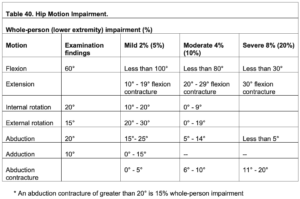Richard Johnson
Principal
In Vicinity Centres PM Pty Ltd v Melek Arik & Ors,[i] a majority of the Victorian Court of Appeal has recently held that the individual and collective skill and expertise of trained medical practitioners appointed to an independent Medical Panel in interpreting and applying the American Medical Association Guides to the Evaluation of Permanent Impairment (4th ed) (AMA4) should be preferred over the imposition of statutory interpretation principles on a document drafted for the use of medical experts. The decision is particularly important in cases where multiple possible interpretations of AMA4 may be open to a Medical Panel.
Melek Arik alleges she slipped and fell on a wet floor at a shopping centre managed by Vicinity Centres PM Pty Ltd (Vicinity) on 16 June 2019, and suffered injuries to her right knee, right hip, and lower back.
Ms Arik served a certificate of assessment authored by an orthopaedic surgeon and Vicinity referred the assessment to a Medical Panel.
The focus of the assessment was the alleged injury to her right hip, to be assessed by reference to range of motion under Chapter 3.2e and Table 40 of AMA4. The Medical Panel made the following assessment under Table 40:

The Medical Panel assessed no impairment in extension and abduction contracture, a mild impairment in internal rotation, abduction and adduction, and a moderate impairment in flexion and external rotation.
The Medical Panel interpreted Chapter 3.2e and Table 40 to require that it should assess WPI on the basis of the highest impairment rating set out in the table (being a moderate impairment), rather than combining the impairment values through each separate plane of motion, with the result being that her WPI assessed at 4%.
Accordingly, on 1 July 2021, the Medical Panel determined that Ms Arik did not suffer a “significant injury”. Consequently, she was barred from claiming for NEL damages.
Ms Arik sought judicial review of the determination,[ii] on the basis there was a jurisdictional error by the Panel in its interpretation of Chapter 3.2e and Table 40. She submitted the Panel did not assess her degree of impairment arising from her right hip injury correctly in accordance with the AMA4, and instead should have combined the values in each row, which would have resulted in a WPI of 14%.
The judicial review application was heard by Justice Richards of the Supreme Court of Victoria. Her Honour accepted Ms Arik’s submission, held there was jurisdictional error based on an incorrect interpretation of Table 40 in Chapter 3.2 of AMA4, and remitted the matter for re-consideration before a new Medical Panel.
Vicinity appealed her Honour’s decision to the Victorian Court of Appeal.[iii]
In allowing the appeal, the majority[iv] held that the Court’s role of judicial review does not permit the Court to construct AMA4 as if it was legislation or legal text, the Court has no role in making its own assessment of impairment, and the choice and application of various methodologies in AMA4 may involve the application of medical expertise and judgement.
In relation to Table 40 specifically, the majority noted that the 2 constructions advocated by the parties each provided a certainty of outcome and there was no basis for preferring one construction over the other within the text.
Importantly, the majority held that the Medical Panel did not find that each limitation on the various planes of motion identified amounted to separate impairments, and that Table 40 did not require the Panel to arrive at that conclusion.
In reaching this conclusion, the majority noted that the Act requires the Panel to interpret AMA4 “… using the members’ individual and collective skill and expertise as medical practitioners and that their approach to [AMA4] is not to be supplanted merely because the court comes to a different view as to how it might be interpreted. It is necessary to go further and show that the methodology is not in accordance with the Guides…” for there to be a legal error (emphasis added).
Accordingly, the majority held that, in circumstances where the conclusion it made was open to it, the Medical Panel could not be determined to have failed to make its assessment in accordance with AMA4, and so there could not be legal error.
In her dissenting opinion, Kennedy JA undertook a more legalistic approach with respect to interpretation of Table 40 and Chapter 3.2e, which was consistent with the findings at first instance.
This decision reiterates the role that Medical Panels play in interpreting AMA4, and the Court’s limited role in judicial review.
Importantly, for there to be identifiable jurisdictional error on the part of a Medical Panel, the Panel must have reached a conclusion which was not open to it under AMA4, rather than being contrary to a particular reading of AMA4 informed by statutory interpretation principles.
While the decision relates specifically to Table 40 and its surrounding context, its application extends to a number of other tables in AMA4, where multiple interpretations may be available.
Accordingly, respondents and insurers should be aware that multiple interpretations of the text of AMA4 may be open to a Medical Panel in a particular case, and the Panel will use its medical skill and expertise to apply the relevant Chapters of AMA4 to a claimant’s injuries. Judicial review will only be available in such cases where the Panel’s interpretation was not open on the text so as to create a jurisdictional error.
[i] [2023] VSCA 295
[ii] [2023] VSC 94
[iii] Niall, Kennedy and Macaulay JJA
[iv] Niall and Macaulay JJA